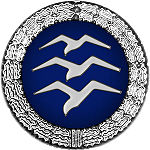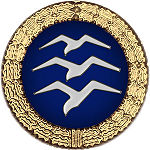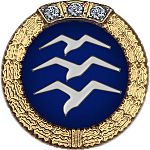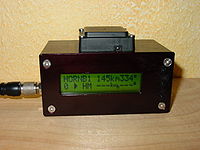- FAI Gliding Commission
-

The International Gliding Commission (IGC)[1] is a leading international governing body for the sport of gliding.
It is one of several Air Sport Commissions (ASC) of the Fédération Aéronautique Internationale (FAI)[2], or "World Air Sports Federation". FAI is the world body for sporting aviation and the certification of world records for aeronautics and astronautics and was founded in 1905.
When the IGC was founded in 1932, it was called CIVV (Commission Internationale de Vol à Voile) and has also been called CVSM (Commission de Vol Sans Moteur). It is the FAI commission responsible for the international competitions, records and badges that apply to gliders and motor gliders. The term "sailplanes" is sometimes used. Hang gliders and paragliders have a separate body called the FAI CIVL Commission[3], which stands for "Commission Internationale de Vol Libre".
Within FAI, the sport of glider aerobatics is managed by the FAI Aerobatics Commission (CIVA),[4] which stands for "Commission Internationale de Voltige Aérienne" and also deals with powered-aircraft aerobatics [1]
Contents
Badges
In the early 1920s two flying organizations, the Association of the German Model and Gliding Clubs, and the Rhön Soaring Association, determined that pilots would be listed as "A" level if they flew a glider for either 300 meters or 30 seconds, and "B" level if they made two flights of 45 seconds in straight lines plus one of 60 seconds in an "S" pattern. (It should be remembered that these flights were made by bungee cord launches down hillsides.) In time a "C" level, requiring a five minute flight, was added. A few years later Fritz Stamer, chief flight instructor of an early gliding school, designed the gull insignia which were used for these awards and later for the badges.
ISTUS (Internationale Studienkommission für motorlosen Flug), was founded in Frankfurt on 13 June 1930, to record international gliding achievements. The founding nations were Belgium, France, Holland, Hungary, Germany, Italy, and the USA. A series of badges for gliding was devised called A, B, C, D etc.
Later the D badge became known as the Silver C, and more often today just the Silver Badge. Earning the Silver C Badge shows that a glider pilot has achieved an altitude gain of at least 1,000 m, made a five-hour duration flight, and has flown cross-country for a straight-line distance of at least 50 km: these three attainments are usually, but not invariably, achieved in separate flights[5]. The first recipients of the Silver C were Wolf Hirth and Robert Kronfeld on 15 February 1931.
In 1932 the FAI recognized gliding, and formed a new section: the Commission Internationale de Vol à Voile (CIVV). This eventually took over the role of ISTUS. The FAI decided that the Silver C was sufficiently meritorious to be internationally recognised, and issued the first 300 before turning the awarding over to the national societies. From the beginning the lesser badges were only recorded by local gliding associations, and their criteria varies, although they are usually integrated into organized training programs. For example, in the United States a Bronze Badge is issued for demonstrated pre-cross country flying skills beyond the C level. In Britain a pilot progresses from the B to the Bronze level and then receives an additional endorsement for cross-country training.
The E badge (later called the Gold C and now usually just the Gold Badge) was established in 1935. A pilot who has completed the Gold Badge has flown 300 km, though not necessarily to a pre-defined goal, gained 3,000 m in height and has made a five hour flight (only one has to be done to count for both the Silver and Gold). Up to this level the badges are registered only by the national gliding associations.
The F Badge (now the Diamond Badge) started in 1949. The Diamond Badge requires three achievements: flying 300 km to a pre-defined goal, going 500 km in one flight (but not necessarily to a pre-defined goal), and gaining 5,000 m in height. Earning all three "diamonds" qualifies the pilot for the FAI registry as a Diamond Badge holder.[6] The FAI also issues a diploma for a flight of 1,000 km and further diplomas for increments of 250 km[7].
Gliding records
The wide variety of records have been defined by the FAI Gliding Commission. The classes of glider have been combined into four groups: Open, 15 metre, World Class and Ultralight. Although female pilots can claim world records in these general categories, there are also additional records in these categories just for female pilots. Because of the number of records the table below only summarises some of the Open Category gliding records as at the beginning of 2008. A full list is available on the FAI web site[8].
Open class records
Category Record Date Pilot Crew Place Glider Free distance 2,192.9 km 04/12/2004 Terrence Delore
 NZL
NZLSteve Fossett
 USA
USAEl Calafate
ArgentinaSchleicher ASH 25 Mi Free out-and-return-distance 2,247 km 02/12/2003 Klaus Ohlmann
 Germany
GermanyChapelco
ArgentinaSchempp-Hirth Nimbus 4 DM Free distance using up to 3 turn points 3,009 km 21/01/2003 Klaus Ohlmann
 Germany
GermanyChapelco
ArgentinaSchempp-Hirth Nimbus 4 DM Distance using up to 3 turn points 2,501 km (to be ratified) 13/12/2009 Terrence Delore
 NZL
NZLJohn Kokshoorn
 NZL
NZLOmarama
New ZealandSchleicher ASH 25 Distance over a triangular course (see below) 1,556.3 km 23/11/2006 Klaus Ohlmann
 Germany
GermanyHerbert Pirker
 Austria
AustriaZapala
ArgentinaSchempp-Hirth Nimbus 4 DM Speed over a triangular course of 100 km 289.4 km/h 18/12/2006 Klaus Ohlmann
 Germany
GermanyEsteban Fechino
 Argentina
ArgentinaZapala
ArgentinaSchempp-Hirth Nimbus 4 DM Speed over a triangular course of 300 km 225.69 km/h 21/11/2005 Klaus Ohlmann
 Germany
GermanyChos Malal
ArgentinaSchempp-Hirth Nimbus 4 DM Speed over a triangular course of 500 km 194.79 km/h 23/11/2005 Klaus Ohlmann
 Germany
GermanyKathrin Woetzel
 Germany
GermanyChos Malal
ArgentinaSchempp-Hirth Nimbus 4 DM Absolute Altitude 15,460 m 29/08/2006 Steve Fossett
 USA
USAEinar Enevoldson
 USA
USAEl_Calafate
ArgentinaGlaser-Dirks DG-500 Gain of Height 12,894 m 25/02/1961 Paul F. Bikle  USA
USAFox Airport, Lancaster, CA
USASchweizer SGS 1-23 E Note: A flight on 12 January 2011 from Chapelco in Argentina by Klaus Ohlmann in a Nimbus 4DM over a triangular course of 1756.1km at 125km/h has been submitted for ratification.[9]
Discontinued records
Class Category Record Date Pilot Crew Place Glider Single seat Duration 56h 15mn 02/04/1952 Charles Atger  France
FranceRomanin-les-Alpilles
FranceArsenal Air 100 GNSS flight recorders
With the advent of satellite navigation equipment at an affordable price, the International Gliding Commission of FAI developed a technical specification [10] for approved flight recorders. The IGC-approved flight recorders provide precise evidence of position for competitions, world records and FAI awards and other activities. The replace earlier methods of observation that used photographic evidence or ground-based observers to record aircraft position. The IGC-approved recorders include a pressure altitude sensor and a Global Navigation Satellite System (GNSS) receiver.[11] They also include data output in a standard ASCII-based format, the "IGC flight data format". This format is used in files with the suffix "IGC" that is specified in detail in Appendix 1 of the document "Specification for IGC-approved GNSS Flight Recorders" that is available on the IGC GNSS web site. It should also be mentioned that organisations outside IGC also use IGC-approved flight recorders and the IGC flight data file format.
In IGC-approved recorders, GNSS and pressure altitude data is continuously recorded during flight in the form of regular fixes stored in non-volatile memory inside the recorder. Typical fix intervals, set by the pilot before flight, are between 5 and 15 seconds for "cruising" flight between turn points, and between 1 and 2 seconds at or near turn points or other points of interest.
The pressure altitude system in an approved recorder has the same function as a barograph and must be calibrated to the ICAO ISA (International Civil Aviation Organisation International Standard Atmosphere). Re-calibrations to check any errors from the ICAO ISA are carried out at regular intervals in the same way as an analogue barograph that uses an aneroid pressure sensor rather than an electronic pressure transducer. Recorded GNSS fix data replaces the need for photography to certify the track over ground and in particular whether a particular turn points has been reached. GNSS altitude data can be compared after flight with the pressure altitude data from the independent sensor in the recorder and this is a valuable check that both systems are working correctly.
In March 1995, the IGC created their "GNSS FR Approval Committee" (IGC GFAC) to test recorders for compliance with the Commission's rules, the FAI Sporting Code Section 3 (Gliders and Motor Gliders). GFAC also issues IGC-approval documents for approved types of recorder and these documents are posted on the IGC GNSS web site.
For IGC-approval, the recorder design includes adding a security code to the downloaded file of flight data. This code and the file data itself can be checked ("validated") at any time later using a validation program originating from the recorder manufacturer that is posted on the IGC GNSS web site for general use. This validation program checks three things. (1) That the file has properly originated from an approved type of recorder, (2) That the recorder has not been altered from its IGC-approved state, (3) That the data in the downloaded file that is being validated is identical to when it was originally downloaded form the recorder. This allows the data to be used for the validation of flight performances up to and including world records.
There are three levels of IGC-approval and at the higher levels a public/private key encryption system such as RSA or equivalent is used to achieve the validation process above. Recorders at the higher approval levels also have a security device such as a microswitch that operates if the recorder is opened. This enables unauthorised modification to the recorder to be detected and protects the integrity of its output data.
OSTIV
An associated body is Organisation Scientifique et Technique du Vol à Voile (OSTIV) which facilitates contact between glider manufacturers and pilots to share experience and opinion
Awards
The Commission makes awards for great achievements and meritorious service. For gliding it presents:
- The Lilienthal Gliding Medal
- Pelagia Majewska Gliding Medal (for female pilots)
- The Pirat Gehriger Diploma (for services to international gliding)
The Lilienthal Medal was instituted in 1938 "to reward a particularly remarkable performance in gliding, or eminent services to the sport of gliding over a long period of time". The first recepiant was Tadeusz Gora in recognition of the his 577.8KM flight. Its recipients include[12]:
- Paul Bikle
- Anne Burns
- Janusz Centka
- Tadeusz Gora
- Hans-Werner Grosse
- Wolf Hirth
- Paul MacCready
- Edward Makula
- George B. Moffat, Jr.
- Klaus Ohlmann
- Derek Piggott
- Helmut Reichmann
- Ingo Renner
- Richard Schreder
- Ann Welch
- Philip Wills
External links
References
- ^ a b FAI Gliding Commission - IGC
- ^ Fédération Aéronautique Internationale - FAI
- ^ FAI Hang Gliding and Paragliding Commission - CIVL
- ^ FAI Aerobatics Commission - CIVA
- ^ Specification of the badges
- ^ A History of American Soaring, by Ralph S. Barnaby. Soaring Society of America, 1974.
- ^ List of recipients of diplomas for 1,000km and over
- ^ FAI List of gliding records
- ^ OLC Contest web site Accessed 13 January 2011
- ^ http://www.fai.org/gliding/gnss/tech_spec_gnss.asp Technical specification of recorders
- ^ http://www.fai.org/gliding/gnss/FAI page on recorders
- ^ List of recipients of Lilienthal Medal
Categories:- Gliding associations
- 1932 establishments
Wikimedia Foundation. 2010.





